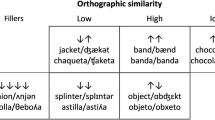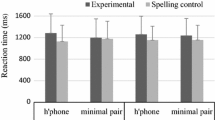Abstract
Does native language phonology influence visual word processing in a second language? This question was investigated in two experiments with two groups of Russian-English bilinguals, differing in their English experience, and a monolingual English control group. Experiment 1 tested visual word recognition following semantic categorization of words containing four phonological vowel contrasts (\({/{{\rm i}}/-/{{\rm u}}/, /{{\rm I}}/-/\wedge/, /{{\rm i}}/-/{{\rm I}}/, /{{\varepsilon}}/-/\ae/}\)). Experiment 2 assessed auditory identification accuracy of words containing these four contrasts. Both bilingual groups demonstrated reduced accuracy in auditory identification of two English vowel contrasts absent in their native phonology (\(/{{\rm i}}/-/{{\rm I}}/, /{\varepsilon}/-/\ae/\)). For late- bilinguals, auditory identification difficulty was accompanied by poor visual word recognition for one difficult contrast (/i/-/I/). Bilinguals’ visual word recognition moderately correlated with their auditory identification of difficult contrasts. These results indicate that native language phonology can play a role in visual processing of second language words. However, this effect may be considerably constrained by orthographic systems of specific languages.
Similar content being viewed by others
References
Aoyama K., Flege J.E., Cuion S.G., Akahane-Yamade R. and Yamada T. (2004). Perceived phonetic dissimilarity and L2 speech learning: The case of Japanese /r/ and English /l/ and /r/. Journal of Phonetics 32: 233–250
Best, C. T. (1995). A direct-realist view of cross-language speech perception. In W. Strange (Ed.), Speech perception and linguistic experience (pp. 171–204). York Press.
Bohn, O.-S. (1995). Cross-language speech perception in adults: Cross-language transfer doesn’t tell it all. In W. Strange (Ed.), Speech perception and cross-language experience (pp. 279–304). York Press.
Flege, J. E. (1995). Second language speech learning: Theory, findings and problems. In W. Strange (Ed.), Speech perception and linguistic experience (pp. 233–278). York Press.
Flege J.E., Munro M. and Fox R. (1994). Auditory and categorical effects on cross-language vowel perception. Journal of the Acoustical Society of America 95: 3623–3641
Gathercole S. and Baddeley A. (1993). Working memory and language. Erlbaum, Hillsdale, NJ
Goldinger S.D., Luce P.A., Pisoni D.B. and Marcario J.K. (1992). Form-based priming in spoken word recognition: The roles of competition and bias. Journal of Experimental Psychology: Learning, Memory, and Cognition 18: 1211–1238
Haigh C.A. and Jared D. (2007). The activation of phonological representations by bilinguals while reading silently: Evidence from interlingual homophones. Journal of Experimental Psychology: Learning, Memory and Cognition 33(4): 623–644
Jia G., Strange W., Wu Y., Collado J. and Guan Q. (2006). Perception and production of English vowels by Mandarin speakers: Age-related differences vary with the amount of L2 exposure. Journal of the Acoustical Society of America 119(2): 1118–1130
Katz L. and Frost R. (1992). Reading in different orthographies: The orthographic depth hypothesis. In: Frost, R. and Katz, L. (eds) Orthography, phonology, morphology and meaning, pp 67–84. Elsevier, Amsterdam
Kucera H. and Francis W.N. (1967). Communicational analysis of present day American English. Brown University Press, Providence, RI
Lesch M.F. and Pollatsek A. (1993). Automatic access of semantic information by phonological codes in visual word recognition. Journal of Experimental Psychology: Learning, Memory and Cognition 19: 285–294
Levey, S. (2006). Variables that affect bilingual Spanish/English and English-speaking children’s word recognition skills. Retrieved August 30, 2007 from http://www.speechpathology.com/articles/article_detail.asp?article_id=297.
Levy E.S. and Strange W. (2008). Perception of French vowels by American English adults with and without French language experience. Journal of Phonetics 36: 141–157
Lukatela G., Eaton T., Sabadini L. and Turvey M.T. (2004). Vowel duration affects visual word identification: Evidence that mediating phonology is phonetically informed. Journal of Experimental Psychology: Human Perception and Performance 30: 151–162
Lukatela G. and Turvey M.T. (1991). Phonological access of the lexicon: Evidence from associative priming with pseudohomophones. Journal of Experimental Psychology: Learning, Memory and Cognition 17: 951–966
McBride-Change C. (1995). Phonological processing, speech perception and reading disability: An integrative review. Educational Psychologist 30: 109–121
Paap K.R. and Noel R.W. (1991). Dual-route models of print and sound: Still a good horse race. Psychological research 53: 13–24
Perfetti, C. A. (1999). Comprehending written language: A blueprint of the reader. Oxford University Press.
Polka L. and Strange W. (1985). Perceptual equivalence of acoustic cues that differentiate /r/ and /l/. Journal of the Acoustical Society of America 78(4): 1187–1197
Sasaki, M. (2005a). The cognition of L and R in written language by the Japanese L2 user of English. Paper presented at Japan Association of College English Teachers Annual Convention, Tokyo.
Sasaki M. (2005b). The effect of L1 reading processes on L2: a cross linguistic comparison of Italian and Japanese users of English. In: Cook, V.J. and Bassetti, B. (eds) Second language writing systems, pp 289–308. Clevedon, Multilingual Matters
Seidenberg M.S., Waters G.S., Barnes M.A. and Tanenhaus M.K. (1984). When does irregular spelling or pronunciation influence word recognition?. Journal of Verbal Learning and Verbal Behavior 23: 383–404
Siegel L. (1993). Phonological processing deficits as the basis of a reading disability. Developmental Review 13: 246–257
Strange, W. (Ed.) (1995). Speech perception and linguistic experience. York Press.
Strange W., Weber A., Levy E.S., Shafiro V., Hisagi M. and Nishi K. (2007). Acoustic variability within and across German, French, and American English vowels: Phonetic context effects. Journal of the Acoustical Society of America 122(2): 1111–1129
Studnitz R.E. and Green D. (2002). Interlingual homograph interference in German–English bilinguals: Its modulation and locus of control. Bilingualism: Language and Cognition 5: 1–23
Trubetzkoy, N. (1939/1969). Principles of phonology (C. A. Baltaxe, Trans.). Berkeley, CA: University of California Press.
Tsukada K., Birdsong D., Bialystok E., Mack M., Sung H. and Flege J.E. (2005). A developmental study of English vowel production and perception by native Korean adults and children. Journal of Phonetics 33: 263–290
Vellutino F.R. and Scanlon D. (1987). Phonological coding, phonological awareness and reading ability: Evidence from a longitudinal and experimental study. Merrill-Palmer Quarterly 33: 321–363
Wade-Woolley L. (1999). First language influences on second language word reading: All roads lead to Rome. Language Learning 49(3): 447–471
Author information
Authors and Affiliations
Corresponding author
Rights and permissions
About this article
Cite this article
Shafiro, V., Kharkhurin, A.V. The Role of Native-Language Phonology in the Auditory Word Identification and Visual Word Recognition of Russian–English Bilinguals. J Psycholinguist Res 38, 93–110 (2009). https://doi.org/10.1007/s10936-008-9086-y
Received:
Accepted:
Published:
Issue Date:
DOI: https://doi.org/10.1007/s10936-008-9086-y




